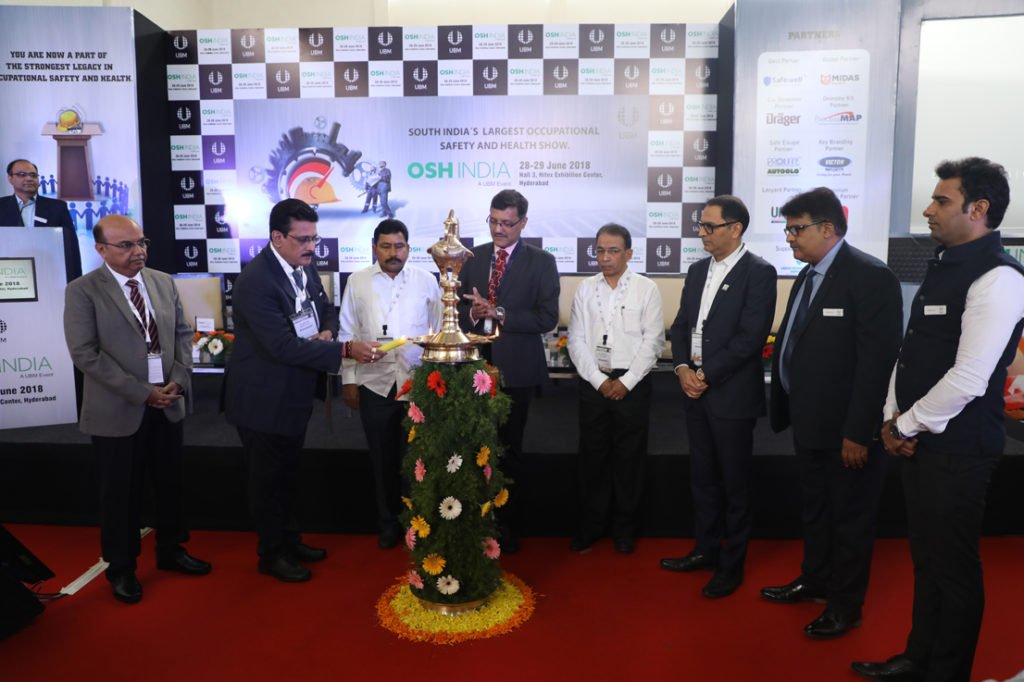‘Without access to any kind of formal training on Occupational Safety & Health (OSH), the overall awareness levels in India are low’.

In June, Hyderabad hosted the 5th edition of OSH South India, an exhibition which brings together more than 6,000 national and international key industry professionals across construction, manufacturing, PPE and other key industry domains.
Part of the show, which had previously taken place in Chennai, consisted of a two-day conference around the most pressing OSH issues in Construction, Pharmaceutical, Manufacturing and Heavy Engineering, among other sectors. The conference also featured a two-hour workshop by the Bureau of Indian Standards.
A key message highlighted by many speakers was that health and safety is considered to primarily be the responsibility of the employees themselves. Unfortunately, without access to any kind of formal training on OSH, the overall awareness levels are low. Key stakeholders were encouraged to effectively communicate the cost-benefit ratio of adopting best practices in OSH.
It was also observed that in these times of severe economic stress, workers often face job security issues and are sometimes forced to work under extreme hardships, risking their lives and putting their families at risk of losing livelihood. Even worse is the risk of causing permanent damage to their physical wellbeing and with it the ability to carry out their professional responsibilities.
All of this calls for organisations to be extra cautious as far as safety and health of workers is concerned. Moreover, those working in chemical industries as well as in industries where lot of toxins are continuously released in the environment as part of industrial processing are perpetually at risk of developing occupational diseases that include respiratory diseases such as asthma, silicosis, asbestosis, COPD; skin related diseases and allergies; cancer; musculoskeletal disease, neuro disorders; mental and emotional stress.
Risk assessment
In India, all organisations are legally obliged to conduct regular health and safety risk assessments to identify any occupational hazards that might be present in the workplace and take steps to alleviate them. They are required to regularly undertake safety audits and plug loopholes that could be found as a result. The Pharmaceutical industry is one that is said to require the utmost attention, in regard to worker safety and health, with employees dealing with a lot of chemicals and active ingredients.
Occupational health and safety policy in India
 The Constitution of India provides detailed provisions for the rights of the citizens and also lays down the principles in the governance of the country, called ‘Directive Principles of State Policy’.
The Constitution of India provides detailed provisions for the rights of the citizens and also lays down the principles in the governance of the country, called ‘Directive Principles of State Policy’.
Occupational Safety and Health is one of the subjects allotted to Ministry of Labour & Employment, under the Government of India Allocation of Business Rules. The Industrial Safety and Health branch of the Ministry discharges the overall functions relating to policy decisions and laying down guidelines for countrywide adoption of legislation.
On the basis of Directive Principles as well as international instruments the Government of India, Ministry of Labour & Employment, declared the National Policy on Safety, Health and Environment at Workplace (NPSHEW) on 20 February 2009.
The purpose of this National Policy is to establish a preventive safety and health culture in the country through elimination of the incidents of work related injuries, diseases, fatalities, disasters and to enhance the wellbeing of employees in all the sectors of economic activity in the country.
The salient features of the Policy are:
- Recognising safe and healthy working environment as a fundamental human right.
- Enhancing the wellbeing of the employees and the society at large by eliminating work related injuries, diseases, etc.
- Bringing into focus the objective of continuous reduction in the incidence of work related injurious and diseases.
Major OSH laws and regulations
On the basis of these Directive Principles and international instruments, the Indian Government declares its policy, priorities, strategies and purposes through the exercise of its power. The Government has enacted the laws relating to Occupational Safety and Health at workplaces and, at present, comprehensive safety and health laws for regulating Occupational Safety and Health at workplaces mainly exist in four sectors, manufacturing, mining, ports, and construction.
There are four main legislations that cover Occupational Safety and Health at workplace:
(i) The Factories Act, 1948, covering factories wherein the enforcement of safety at workplace is by the Chief Inspector of Factories in the respective states;
(ii) The Mines Act, 1952 and Mines Rules, 1955 for mining industry where the enforcement is by the Directorate General of Mines Safety (DGMS) under Ministry of Labour & Employment, Government of India;
(iii) The Dock Workers (Safety, Health and Welfare) Act, 1986 followed by notification of the Dock Workers (Safety, Health and Welfare) Regulations, 1990 dealing with the major ports of India and the enforcement is by the Directorate General of Factory Advice Service & Labour institutes (DGFASLI), under Ministry of Labour & Employment, Government of India,
(iv) The Building & Other Construction Workers (Regulations of Employment and Conditions of Service) Act, 1996, covering construction workers at construction sites wherein the enforcement is by the Directorate General Labour Welfare in the central sphere and by the Labour Commissioners/Factory Inspectorates in the States/UTs.
Implementation
Under the Ministry of Labour, Government of India, there are various agencies responsible for the implementation and monitoring of these laws and regulations. They are DISH, DGFASLI, Directorate of Factories, Municipal Corporations, Regional Fire Offices and Labour departments of state governments. The different parliamentary panels also make frequent amendments to existing labour laws, in order to make them more potent. For a huge and diverse country like India, the results are pretty decent. However, there remains a need to educate people further about the need for safety across all sectors of the industry, as well as on the various equipment available to enhance safety.

What makes us susceptible to burnout?
In this episode of the Safety & Health Podcast, ‘Burnout, stress and being human’, Heather Beach is joined by Stacy Thomson to discuss burnout, perfectionism and how to deal with burnout as an individual, as management and as an organisation.
We provide an insight on how to tackle burnout and why mental health is such a taboo subject, particularly in the workplace.


 The Constitution of India provides detailed provisions for the rights of the citizens and also lays down the principles in the governance of the country, called ‘Directive Principles of State Policy’.
The Constitution of India provides detailed provisions for the rights of the citizens and also lays down the principles in the governance of the country, called ‘Directive Principles of State Policy’.
